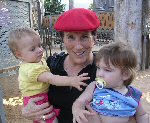
The Sky Is Indeed the Limit
June 9, 2017
The assignment sounded straightforward. My American publisher asked me to update my children's biography Ilan Ramon, Israel's Space Hero, which came out in 2004, soon after Israel's only astronaut died in the failed re-entry of space shuttle Columbia on February 1, 2003. The text was checked and approved by Ilan's wife, Rona.
A test group among young American readers asked for additional explanations.
In 2017, they were unsure about what I'd meant about the Arab nations threatening to "drive Israel into the sea" at the brink of the Six Day War.
That's when Ilan became a bar mitzva in his hometown of Beersheba. One of my Israeli grandsons felt I should explain why windows were blacked out then.
Happily, he'd never experienced that.
In a chapter called "Remembering Ilan," there were many memorials to add. Ilan Ramon remains an inspirational role model. A hill on Mars and a crater on the far side of the moon are named for him. So are the control tower at Ben-Gurion Airport, the emergency room at Rehovot's Kaplan Hospital, parks, playgrounds and science programs.
At least six Israeli schools bear his name, plus a school in Agoura, California.
I needed to include the intriguing story of Ramon's notebook surviving amid the smoldering wreckage that fell to Earth. On April 4, two months after the disaster, a Native American tracker in Texas came upon a small pile of papers in a field. The Columbia was traveling at nine kilometers a second when it disintegrated.
The aluminum vaporized. The iron boiled. Could these white loose-leaf papers with writing in pencil and black ink have traveled all the way from space? The visible writing was in a language unfamiliar to the tracker – Hebrew. He'd found 20 pages of Ramon's crew notebook.
Rona brought the diary to Israel. Jerusalem police detective Sharon Brown unstuck and opened the curled paper.
Using police technology, blurs turned into letters. There was a list of topics that Ilan wanted to speak about, including the beauty of the Earth and about the importance of his tiny Torah scroll.
Written out was the entire Kiddush recited over wine and the week's Torah portion, a biblical account of the Israelites being freed from Egypt and the sea splitting so they could cross. Of course this material, poignant as it is, needed to be included.
But the toughest dilemma remained.
In a children's book, wasn't it too sad to write about the death of Ilan's son, Asaf, at age 21? How much tragedy should one children's book contain? The Ramons had four children. From age 5, Asaf, the oldest, wanted to be a pilot. One can't even imagine the mixture of pride and trepidation for Rona as Asaf went through tryouts and training.
He was the first Israeli pilot to follow in a parent's footsteps to graduate with excellence.
But then, the unthinkable. Asaf died in a training accident in his F-16 in September 2009.
My first instinct was to avoid mentioning Asaf's death. The double tragedy was simply not endurable and overshadowed the positive. On the other hand, I was writing a biography, not a fairy tale.
In the end, I took my clue from the Ramon family. After Asaf's death, Rona found something he had written which she calls "her greatest compliment."
Asaf's expressed his thankfulness for being brought up in a family in which everyone could follow his own calling.
When Asaf went for pilot training, Rona didn't stand in his way. A guiding principle in the Ramon household was to bring up the children to aspire to realize their dreams.
In 2010, Rona established a foundation in memory of both her husband and her son, to help other children fulfill the quest for meaning in their lives.
The Ramon Foundation encourages excellence in school, leadership and courage.
There's an Aviators' Club for 5th to 8th graders who get to spend time with pilots and other air force personnel to help them become school leaders, and another leadership program for high school seniors.
The foundation also sponsors a creative science program in which children send experiments judged worthy to the International Space Station. Tens of thousands of children in Israel, particularly in the neglected periphery, have taken part in these empowerment programs.
When Rona speaks of the loss of her son, it's with unbearable sadness, but at the same time the joy of knowing that he, like his father, was able to pursue his dream. Her own life is enriched by gifting that opportunity to others.
In real families and real countries, multiple tragedies do sometimes occur.
She would say we have to seek joy simultaneously with the ever-present sorrow.
Kids get that.
When he became a pilot, Ilan changed his last name from Wolferman to Ramon, using some of the same letters and honoring the Ramon mahteshim, the beloved craters near Beersheba, where he often hiked with his friends.
Today, at the Ilan Ramon Center in Mitzpe Ramon, the lives both of Ilan and Asaf are honored. On a recent visit, soldiers for a tank commander training course, a group of Chinese carrying parasols, and Israeli schoolchildren followed the space voyage and examined the badges. The interactive site includes Earth science of the region and also proves that, when it comes to dreams, the sky is the limit. May their memories be a blessing.
